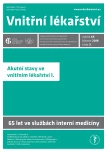An unstable patient in first contact with a doctor in hospital: how to recognize the risk?
Authors:
Vladimír Šrámek
Authors‘ workplace:
Anesteziologicko-resuscitační klinika LF MU a FN u sv.
Published in:
Vnitř Lék 2019; 65(3): 166-169
Category:
Overview
The primary triage of patients on first contact with a physician is crucial for its further direction and it essentially influences the prognosis. In addition to the physician’s experience and given the proper stratification, an important role is played by medical history, basic clinical examinations and laboratory tests. The level of established risk affects the indication for hospital admission or possibly admission to a monitored bed. For each new patient, it is advisable to monitor the development of the overall condition and response to the initiated therapy within the first hours of hospitalization. Team cooperation often helps to get a complete picture of the disease. This article mainly focuses on a situation where a patient comes to a health facility with basic medical equipment.
Keywords:
hypoperfusion – lactate – shock
Sources
-
Talley NJ, O’Connor S. Clinical examination. A systematic guide to physical diagnosis. 7th ed. Elsevier. Churchill Livingstone Australia 2013. ISBN 978–0729541473.
-
Ait-Oufella H, Lemoinne S, Boelle PY et al. Mottling score predicts survival in septic shock. Intensive Care Med 2011; 37(5): 801–807. Dostupné z DOI: <http://dx.doi.org/10.1007/s00134–011–2163-y>.
-
Mrgan M, Rytter D, Brabrand M. Capillary refill time is a predictor of short-term mortality for adult patients admitted to a medical department: an observational cohort study. Emerg Med J 2014; 31(12): 954–958. Dostupné z DOI: <http://dx.doi.org/10.1136/emermed-2013–202925>.
-
Joly HR, Weil MH. Temperature of the great toe as an indication of the severity of shock. Circulation 1969; 39(1): 131–138.
-
Puskarich MA, Trzeciak S, Shapiro NI et al. [Emergency Medicine Shock Research Network (EMSHOCKNET)]. Outcomes of patients undergoing early sepsis resuscitation for cryptic shock compared with overt shock. Resuscitation 2011; 82(10): 1289–1293. Dostupné z DOI: <http://dx.doi.org/10.1016/j.resuscitation.2011.06.015>.
-
Yealy DM, Kellum JA, Huang DT et al. [ProCESS Investigators]. A randomized trial of protocol-based care for early septic shock. N Engl J Med 2014; 370(18): 1683–1693. Dostupné z DOI: <http://dx.doi.org/10.1056/NEJMoa1401602>.
-
Singer M, Deutschman CS, Seymour CW et al. The Third International Consensus Definitions for Sepsis and Septic Shock (Sepsis-3). JAMA 2016; 315(8): 801–810. Dostupné z DOI: <http://dx.doi.org/10.1001/jama.2016.0287>.
-
Weil MH, Afifi AA. Experimental and clinical studies on lactate and pyruvate as indicators of the severity of acute circulatory failure (shock). Circulation 1970; 41(6): 989–1001.
-
Leverve XM. Lactate in the intensive care unit: pyromaniac, sentinel or fireman? Critical Care 2005; 9(6): 622–623. Dostupné z DOI: <http://dx.doi.org/10.1186/cc3935>.
-
Bakker J, Jansen TC. Don‘t take vitals, take a lactate. Intensive Care Med 2007; 33(11): 1863–1865. Dostupné z DOI: <http://dx.doi.org/10.1007/s00134–007–0679-y>.
-
Nguyen HB, Rivers EP, Knoblich BP et al. Early lactate clearance is associated with improved outcome in severe sepsis and septic shock. Critical Care Med 2004; 32(8): 1637–1642.
Labels
Diabetology Endocrinology Internal medicineArticle was published in
Internal Medicine

2019 Issue 3
Most read in this issue
- Hemorrhagic shock and treatment of severe bleeding
- Intravenous fluid therapy in acutely ill patients for non-intensivists
- Acute respiratory distress syndrome
- Diagnosing hypovolemia and hypervolemia: from clinical examination to modern methods
